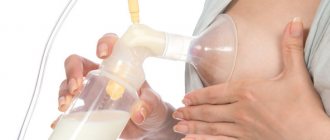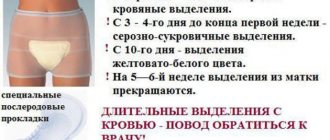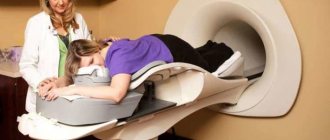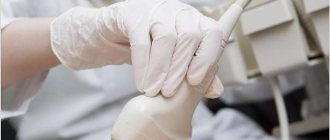Normal course of the postpartum period and the formation of lactation
In the last weeks of pregnancy, an almost colorless liquid begins to secrete from the nipple. This is colostrum, a product with a very high calorie and nutrient density. Even in the delivery room, after cutting the umbilical cord, they try to attach a newborn baby to the breast and express a few drops of colostrum.
It contains very little liquid, which avoids overloading the newborn’s kidneys in the first few days. Colostrum has a laxative effect. This is necessary for successful bowel movement of meconium. Nutrients are in concentrated form, mainly proteins.
Other beneficial properties of colostrum include the following:
- the content of immune factors - immunoglobulin, lymphocytes, neutrophils, which provide passive immunity in the first months of life;
- living T-lymphocytes produce interferons to viruses with which the mother’s body is familiar;
- has factors that stimulate the maturation of the intestinal epithelium and the formation of normal digestion.
After 3-5 days, having passed through the primary milk phase, colostrum is replaced by mature breast milk. At first, only 20 ml per day is produced, but gradually, as the child’s needs grow, up to 900 ml can be released.
Do not be alarmed by the small volume of colostrum; its concentration is sufficient to provide nutrients to the newborn. But a woman can influence the amount of milk on her own.
By the third day after birth, you may notice engorgement of the mammary glands. This is one of the signs that milk is starting to come in. It is not able to leave the gland on its own. The best way is to feed frequently. Under the influence of the act of sucking, the alveoli are emptied and oxytocin is produced. The hormone affects the contractility of the smooth muscles of the chest, and also promotes the involution of the uterus and reduces bleeding.
Often milk comes in such quantities that the baby cannot cope with the breast on his own. It becomes very dense and painful. Expressing the breast can solve the problem. A midwife can help with this in the maternity hospital. The procedure is carried out over a diaper. The breasts are grasped widely with both hands and gradually compressed from the base to the areola. The nipple is not touched. Periodically perform massaging movements over areas with increased density. If you are straining yourself, you can do this under a warm shower.
Some women have an accessory lobe of mammary gland located under the armpits. When expressing, do not forget about it, massage it gently to promote the outflow of milk.
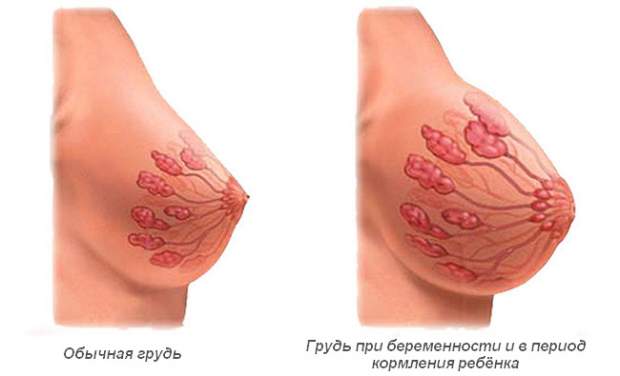
The amount of milk secreted depends on the frequency of breastfeeding. A newborn baby eats every 1.5 hours with a longer break at night. This frequent feeding stimulates milk production.
Milk is supplied from the alveoli reflexively; hormonal and nervous mechanisms are involved in regulation. This process can acquire the features of a conditioned reflex, and can also be inhibited by external stimuli: fear, stress, pain. If, with sufficient secretion, the gland does not empty, then milk production is quickly suppressed and lactation stops completely. Conversely, frequent latching, especially at night, helps increase milk supply.
Symptoms of pathology
Almost always, a woman independently notices that some changes have occurred in her breasts if she is attentive to herself. She will also detect the first symptoms of lactostasis, but she does not always know that it is dangerous.
Before mastitis occurs, milk stagnation always appears, which also manifests itself clinically. The symptoms are as follows:
- feeling of pain and heaviness in the chest;
- a compacted lobule is clearly defined, sensitive to palpation;
- the skin above its surface is not changed, normal color and temperature to the touch;
- body temperature and general health are good.
Moreover, if a woman tries to give her baby a breast with suspected lactostasis, after feeding she will notice a significant improvement in her condition. And soon it will pass.
If the stage of milk stagnation was not noticed, then the clinical picture is brighter and corresponds to the stage of the disease. A brief description can be presented as follows:
| Stage | Symptoms |
| Infiltrative stage | In this case, general health begins to suffer, the first signs of intoxication appear - body temperature within 37 - 38 degrees, weakness, lethargy, headache, etc. In the chest, you can easily identify a dense and painful group of lobules. The skin over them is bright red, and the temperature is increased to the touch. If you offer the breast to a baby at this stage of mastitis, he may take it or refuse. Expressing brings relief, but not for long. Already at this stage, painful and enlarged axillary lymph nodes can be detected. |
| Purulent stage | Characterized by an active inflammatory process. Symptoms of intoxication are pronounced: temperature up to 39 degrees, weakness, nausea, dizziness, chills and sweating, etc. The chest is sharply painful when touched at any time, and is often swollen. It is not always possible to clearly determine the location of the inflamed group of lobules and ducts. The veins under the skin of the breast may also become inflamed: they thicken, and the covering over them turns red. Expressing on your own is impossible, and the baby categorically refuses to suck. Purulent (yellowish, greenish) discharge may be discharged from the nipple. |
| Abscess stage | It is characterized by the formation of a limited focus at the site of inflammation. In this case, all the symptoms of the previous stage are accompanied by acute throbbing chest pain. An abscess forms there, and the cavity is filled with pus. Treatment at this stage is only surgical. |
| Phlegmonous stage | It is formed as a result of the spread of inflammation to all underlying tissues: subcutaneous fatty tissue, chest muscles. The woman’s condition is extremely serious; she may even be delirious. The temperature is high, the mammary glands are extremely painful. |
| Gangrenous stage | It is characterized by thrombosis of the vessels of the mammary gland and death of its tissue. Treatment is breast removal. With ineffective therapy, phlegmon may develop. |
Most often you have to deal with lactostasis, infiltrative, abscess stages. This is only due to the fact that treatment of mastitis after childbirth is in most cases timely and qualified.
Phlegmonous and gangrenous - the most severe, serious complications and deaths cannot be excluded
Feeding rules
The first feeding takes place in the delivery room; immediately after birth, the baby is expressed a few drops of colostrum. The first skin-to-skin contact with the mother ensures the colonization of the newborn's skin with the mother's microflora, as well as the formation of an emotional connection.
Subsequent breastfeeding is performed at the baby's request. Milk output is improved by a glass of milk, warm tea or compote, drunk 10 minutes before feeding. Don't forget about basic hygiene rules - wash your hands with soap. But you don’t need to do this with your breasts. Soap breaks down the thin layer of fat that covers the nipples. They become drier and more susceptible to cracking. Before feeding, it is enough to express a few drops of milk to clear the ducts.
The woman should take a comfortable position and make sure that she is not disturbed at this time. The baby is given feeding from one breast, alternating each time. You need to make sure that it captures not only the nipple, but also the pigmented skin around it - the areola. If applied incorrectly, this can cause cracks in the nipples and disrupt the entire feeding process.
Feeding duration should be about 20 minutes. At first it may cause some discomfort. Irritation of the nipple causes contraction of the uterus, which is accompanied by cramping pain in the lower abdomen. But gradually everything returns to normal, and this process becomes pleasant.
The remaining milk must be expressed. This will stimulate increased production and prevent stagnation. Some people express into a diaper by hand, or you can use breast pumps, which allow you to collect the milk in a sterile container and freeze it. The date of pumping must be signed on the container. You can store it in this form in the freezer for up to 4 months.
Diagnosis and treatment
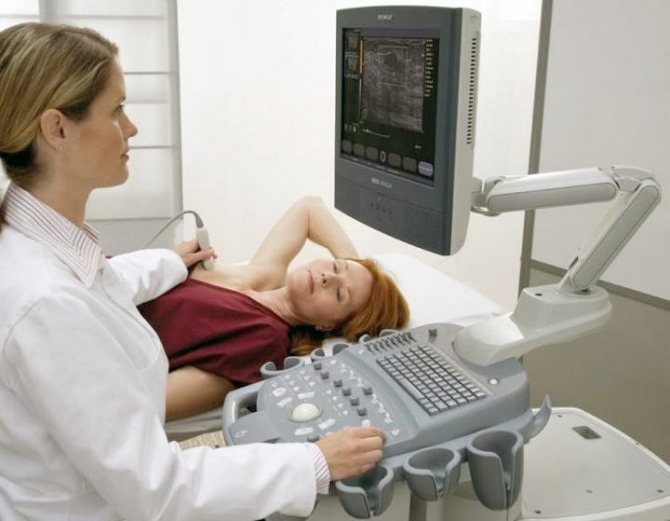
To make a diagnosis, ultrasound of the mammary glands is prescribed
If symptoms of a chest cold begin to appear, you should immediately visit a medical facility to consult a doctor. A mammologist is competent in resolving such issues; if there is no such specialist nearby, a gynecologist deals with the treatment of breast diseases.
An examination is carried out and an anamnesis is collected. To confirm or refute the diagnosis, ultrasound diagnostics of the mammary glands, general and biochemical blood tests are indicated. After 35 years, if the development of malignant neoplasms is suspected, mammography is indicated.
If a pathological condition develops during lactation and the milk changes color, additional samples are sent for bacteriological examination. It is possible to identify pathogens of infectious diseases. Based on the results of the examination, taking into account the individual characteristics of the patient’s body, a therapeutic course is developed.
The treatment regimen is determined by the attending physician. A woman must first coordinate her every action with a doctor. Compositions prepared according to traditional medicine recipes can be used only after the approval of a doctor.
It is important to take special care when using warm compresses.
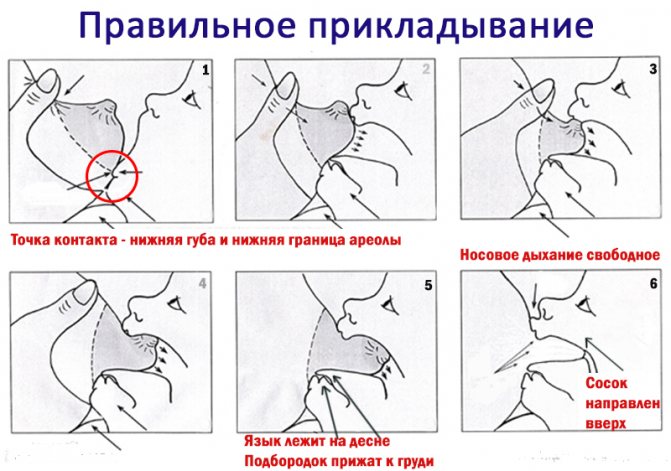
Recommendations for mastitis:
- Put the baby to the breast as often as possible. This will prevent stagnation. If a lot of milk comes in and the baby does not have time to eat everything, it is recommended to use a mechanical or automatic breast pump to help. To ensure uniform emptying of the breast, the newborn must be applied in different positions.
- It is important to relax before feeding to stimulate milk flow. To do this, apply a warm compress to the chest (prohibited for use in purulent forms) or take a warm shower. Magnesia helps relieve spasms from the thoracic ducts. A small amount of the medicinal composition is applied to a piece of rags and applied to the sternum for 15-20 minutes. It is important that during the procedure the composition does not get on the nipples. If this does happen, you need to thoroughly rinse off the remaining drug with plenty of clean water.

Traumeel is used to reduce pain - Applications can be used to reduce swelling of soft tissues. As a rule, ice wrapped in cloth, low-fat cottage cheese or cabbage leaves are used for cold compresses. The procedure should be carried out in between feedings. The effectiveness is due to the fact that cold reduces painful manifestations and blood flow. Among the medications prescribed are Traumeel S and Arnica.
- If necessary, you need to lower the temperature. If it does not rise above 38 degrees, it is not recommended to knock it down so that the body can independently fight pathogens. If the temperature is higher, you need to take a safe antipyretic drug. It is recommended to give preference to Paracetamol or Ibuprofen-based medications. They reduce temperature and relieve pain.
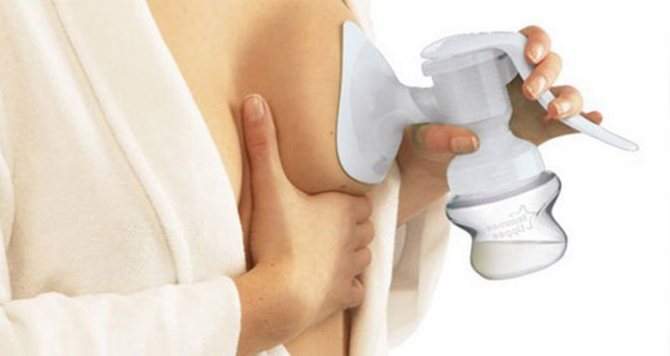
For conservative treatment of mastitis, regular pumping is recommended.
Women who are faced with a similar problem for the first time often make the same mistakes, which inevitably worsens the condition.
- Interruption of lactation. If a woman is forced to stop lactation due to medication, she still needs to express milk.
- Compresses with camphor alcohol or camphor.
- Experiment with medicinal herbs without consulting a doctor.
- Taking medications without a prescription from a mammologist or gynecologist.

It is recommended to wash your chest with a decoction of chamomile and yarrow.
To achieve maximum treatment effectiveness, it is recommended to use traditional medicine approved by a doctor simultaneously with conservative therapy. At the initial stage of development of the disease, the affected breast can be washed with a special infusion. To prepare it you need to mix 2 tbsp. dry mixture of chamomile and yarrow flowers, pour two glasses of boiling water. This composition has a pronounced anti-inflammatory and disinfectant effect.
To reduce swelling, it is recommended to use a honey cake. To prepare the composition, mix 2 tbsp. flour with 1 tbsp. natural honey, make dough. To provide a therapeutic effect, the resulting cake is applied to the affected area and covered with gauze on top. The duration of the procedure is at least 10 hours.
Breast care
Breast restoration after childbirth should begin as early as possible. You should take care of proper nutrition during lactation and a sufficient amount of vitamins. You can enrich your diet with them through special complexes for nursing mothers.
You can massage your breasts in the shower under running warm water. There is no need to use a hard mitten or other devices. It is enough to perform gentle stroking movements with your hands or a stream of water using a shower head. The direction of the massage should be from the fold under the breasts to the armpit. A contrast shower cannot be used: lactating breasts should not be overcooled.
Striae (stretch marks) may form on the skin of the chest. This process is highly individual and depends on the skin’s tendency to form scar tissue. Creams and lotions can slightly reduce this process, but it is impossible to completely stop it in women prone to stretch marks. After pregnancy, you can use Contractubex cream, which can reduce the severity of stretch marks. Under its influence they become pale and barely noticeable. Cosmetics have a less pronounced effect.
Special gymnastics helps improve the condition. The mammary gland is represented by glandular and adipose tissue, so exercises are aimed at strengthening the muscles that support the breasts.
Sets of exercises are aimed at the following muscles:
- muscles located under the mammary gland;
- back muscles;
- formation of correct posture.
During lactation, it is important to choose the right underwear. It should fit in size, not squeeze anywhere, and be made from natural materials. Special nursing bras have a detachable cup. Which allows you not to completely remove the breast.
Breast restoration occurs gradually, but in case of severe changes (ptosis, stretch marks), they resort to cosmetic lifting procedures, as well as surgical operations for breast replacement or mammapexy - lifting sagging breasts.
Breasts during the menstrual cycle
Similar sensations appear depending on the day of the menstrual cycle. In the first phase, estrogen is produced, under the influence of which the growth of adipose tissue occurs, and in the second phase, the hormone progesterone prevails, provoking the growth of glandular tissue. This causes a symptom such as engorgement of the mammary glands before menstruation, which causes some women a lot of inconvenience. Along with swelling and tenderness, pain of varying degrees occurs in the chest.
Pathological conditions of the breast
Not everything always goes well. Pregnancy and hormonal changes after it can become a provoking factor for the development of various pathological conditions.
Mastitis
The lactating gland is susceptible to the development of mastitis, a pathology of lactating women. This is inflammation of the mammary gland, which develops due to a combination of several reasons:
- milk stagnation;
- violation of hygiene;
- pathogenic microflora;
- structural changes in the gland: mastopathy, scars.
Most often, Staphylococcus aureus is found in foci of inflammation; streptococci, Escherichia coli and Bacteroides are detected in much smaller quantities.
Initially, a compaction appears in the mammary gland, it becomes locally painful and hyperemic. This all happens against the background of an increase in body temperature. Purulent discharge from the nipple may appear. This condition develops during any period of lactation, but most often it occurs during the first month after birth. Predisposing factors for the development of mastitis are lactostasis and cracked nipples. A distinctive feature of the disease is the unilateral nature of the lesion.
Treatment depends on the phase and severity of the condition. If mastitis is diagnosed at an early stage, then you can limit yourself to conservative treatment at home.
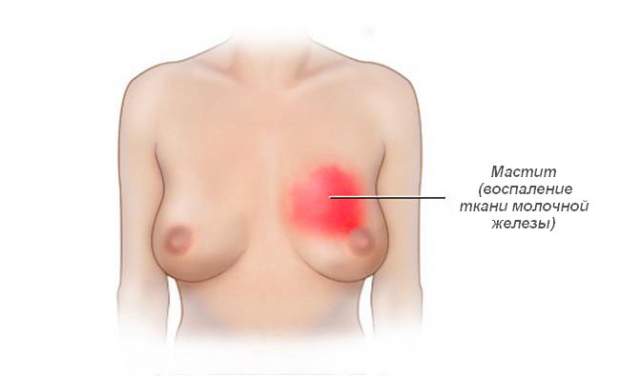
Indications for hospitalization are:
- breast abscesses;
- the need for surgical treatment.
Antibiotics are required in treatment regimens. An indicator of effectiveness is a reduction in symptoms within 2-3 days after the start of therapy. If this does not happen, then the likelihood of surgical intervention is high.
For treatment I use broad-spectrum antibiotics:
- Amoxicillin;
- Oxacillin;
- Cephalexin.
The dosage and frequency of administration are determined individually. The course of treatment should last at least 5 days. Be sure to carry out additional pumping. Some doctors recommend applying a cool compress.
If there is no improvement after 48 hours, additional diagnostics are necessary. In case of abscess formation, surgical treatment is required: under general anesthesia, the lesions are opened and drained. Feeding is suppressed with the help of medications Cabergoline or Bromocriptine. In severe cases, antibiotics are administered intravenously or intramuscularly.
Cyst
During lactation, a breast cyst may form. This is a hollow benign formation that is formed from ducts under the influence of the following reasons:
- congenital curvature of the gland ducts;
- infectious inflammatory reactions;
- injuries;
- non-compliance with feeding rules - long breaks between feedings or a sudden cessation of lactation with a high level of secretion.
Small cysts cannot be noticed on your own. Ultrasound reveals hollow formations with a capsule filled with liquid contents. A large cyst can be felt through the skin in the thickness of the tissue.
Most often, cysts are localized in the nipple area. Its contents are modified milk. During puncture, a dark green or brown color and an unpleasant odor are determined. Depending on the type of content, cysts are divided into oil-like, soap-like, and cheese-like.
If a woman reveals some uncharacteristic formation during feeding, a thorough examination must be carried out.
Treatment is carried out in two ways:
- Puncture of the cyst and suction of its contents.
- Removal of the formation along with the capsule.
The first method can be used during breastfeeding. Complete removal of the cyst is carried out when an infection occurs.
Fibroadenoma
Often, by the time of pregnancy, a woman has some benign formations that can behave differently. Hormonal changes can trigger their growth.
Fibroadenoma can form from connective tissue and fibrous fibers. This is a round formation that is benign in nature. For a long time it may not manifest itself in any way. The skin over it does not change, there is no discharge from the nipple, pain or swelling. The type of fibroadenoma growth may vary. In some cases, this is a formation with a capsule, delimited from surrounding tissues, which grows rapidly. The other type is a slow-growing, benign tumor adherent to surrounding tissues.
Large fibroadenomas are recommended to be removed before pregnancy. This is necessary because it is impossible to predict her behavior during pregnancy. During this period, increased growth of connective tissue occurs, and along with it, the tumor may increase. During pregnancy, fibroadenoma is removed in exceptional cases.
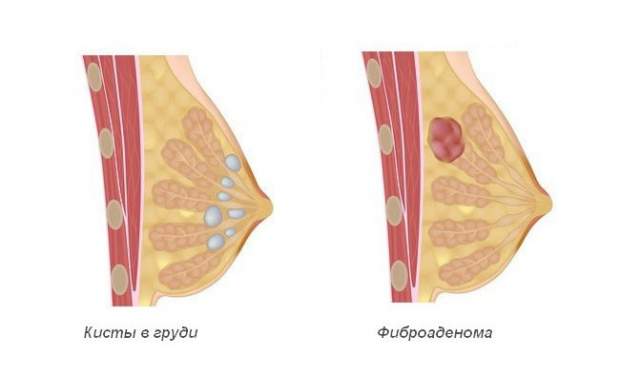
Breast fibroadenoma may shrink significantly after childbirth. This occurs under the influence of increased prolactin and decreased estrogen. The longer a woman breastfeeds, the higher the likelihood of fibroadenoma regression. But those who were diagnosed with a significant tumor before pregnancy should be regularly monitored by a mammologist.
Surgical removal of fibroadenoma is carried out, if necessary, after the complete cessation of lactation.
Cancer
Sufficient lactation is a natural protection against the development of breast cancer. But sometimes hormonal changes in the postpartum period lead to the beginning of a malignant process. Sometimes the disease is detected during pregnancy. Further tactics depend on the degree of the tumor.
A pathological process can be suspected if the following symptoms are present:
- pain in the mammary gland after childbirth or during pregnancy;
- discomfort in the nipple area;
- swelling locally at the site of the tumor;
- enlarged axillary lymph nodes.
Mandatory diagnostics include ultrasound, mammography, trephine biopsy, which allows you to determine the type of tumor.
Treatment is selected individually. A characteristic feature of cancer after childbirth is its more malignant growth and detection at advanced stages.
Treatment of the first and second stages during pregnancy can be carried out with its preservation. In this case, a radical method of surgical removal of the mammary gland is used. Removal of the tumor alone is not used, because Radiation therapy is prohibited during this period. Chemotherapy treatment can be carried out in the 3rd trimester. The drugs are very toxic and have a teratogenic effect. Therefore, they cannot be used until the internal organs are fully formed. Radiation therapy is not used during pregnancy and immediately after childbirth. Its negative impact cannot be reduced.
If the tumor is stage 3, there are two options:
- Maintaining pregnancy until chemotherapy can be administered (up to the 3rd trimester).
- Artificial birth ahead of term or abortion.
In the last stage of cancer detected during pregnancy, the question of the priority of the life of the child or the mother is decided. If the option of saving the child is chosen, then treatment begins only after birth.
Therapy in the postpartum period can be carried out according to the standard regimen. A woman stops breastfeeding. Massive drug and radiation therapy is carried out.
The prognosis of cancer during lactation depends on several factors:
- tumor size;
- flow stage;
- type of cancer;
- mother's symptoms.
Lactation is stopped during chemotherapy.
How many days can swelling last?
Swelling begins to appear 2-3 hours after surgery and reaches its peak on the third day. In this case, it is necessary to monitor the dynamics of the development of complications. When the healing process proceeds correctly, the swelling decreases on days 4-5 and disappears completely on day 7 , regardless of which jaw the implantation was performed on.
If there is a tendency for the area of swelling to increase, this should be a cause for concern.
What symptoms, along with swelling, indicate the development of complications:
- acute pain on day 4-5;
- temperature increase;
- purulent discharge from the socket;
- blueness or redness of the gums;
- implant mobility.
Breast engorgement after childbirth
Causes of breast engorgement during breastfeeding:
- excess milk production in the first days after childbirth;
- irregular feeding or pumping;
- abrupt cessation of breastfeeding;
- violation of the feeding regime or decreased appetite of the child due to illness;
- late latching of the baby in the maternity hospital.
Breast should be given to the baby immediately after birth.
Excessive engorgement of the mammary glands occurs because the baby does not latch onto the breast correctly, and therefore:
- eats little milk, not completely emptying the mammary glands;
- tries to grab the full breast, forming painful cracks on the nipples.
If this problem is ignored, the milk ducts will be blocked and infection will occur - mastitis.
What you need to do to reduce breast engorgement:
- Put the baby to the breast at least 10 times a day.
- Watch the capture. Feed according to every requirement. Signs: eyes move quickly, the baby clenches his fists, sucks his hand, tries to grab his hand with his mouth, search reflex. It is imperative to wake up the baby for feeding if he sleeps more than 2-3 hours during the day or more than 4 hours at night.
- Do not limit the baby's feeding time.
- Express by hand or with a breast pump if your baby is sucking poorly or not sucking at all.
- Do not limit yourself in drinking regime during lactation.
Feeding your baby frequently will help reduce pain during lactation.
In some women, engorgement of the mammary glands is present even with an established feeding regimen.
